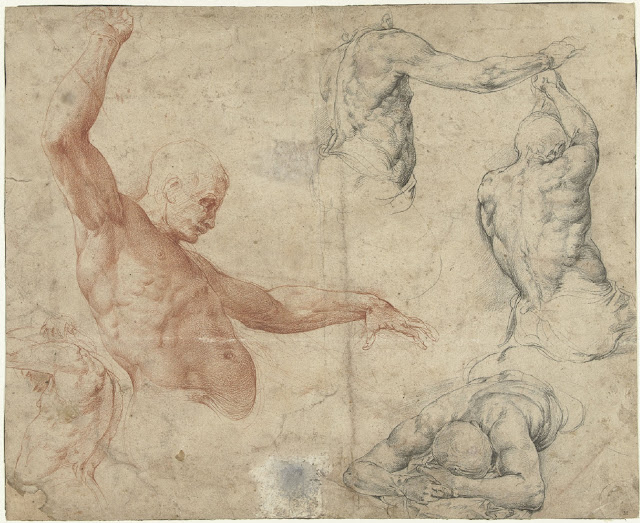 |
| Battista Franco Human Skull in profile ca. 1538 drawing Metropolitan Museum of Art, New York |
 |
| Battista Franco Skull of a Dog before 1561 drawing Teylers Museum, Haarlem |
 |
| Battista Franco Skull of a Dog before 1561 drawing Teylers Museum, Haarlem |
 |
| Battista Franco Figure studies before 1561 drawing Rijksmuseum, Amsterdam |
"Battista Franco, of Venice, having given his attention in his early childhood to design, went off at the age of twenty, as one who aimed at perfection in that art, to Rome, where, after he had devoted himself for some time with much study to design, and had seen the manner of various masters, he resolved that he would not study or seek to imitate any other works but the drawings, paintings, and sculptures of Michelangelo; wherefore, having set himself to make research, there remained no sketch, study, or even anything copied by Michelangelo that he had not drawn. Wherefore no long time passed before he became one of first draughtsmen who frequented the [Sistine] Chapel of Michelangelo, and, what was more, he would not for a time set himself to paint or to do any other thing but draw."
* * *
"Battista then returned to Rome [in 1538] at the very time when the Judgment of Michelangelo had just been uncovered; and, being a zealous student of the manner and works of that master, he gazed at it very gladly, and in infinite admiration made drawings of it all."
* * *
"It is true, however, that Battista was not at that time [1548] in Urbino, but in Rome, where he was engaged in drawing not only the statues but all the antiquities of that city, and in making, as he did, a great book of them, which was praiseworthy work. Now, while Battista was giving his attention to drawing in Rome, Messer Giovanni Andrea dell' Anguillara, a man truly distinguished in certain forms of poetry, having got together a company of various choice spirits, was causing very rich scenery and decorations to be prepared in the large hall of S. Apostolo, in order to perform comedies by various authors before gentlemen, lords, and great persons. He had caused seats to be made for the spectators of different ranks, and for the Cardinals and other great prelates he had prepared certain rooms from which, through jalousies, they could see and hear without being seen. And since in that company there were painters, sculptors, architects, and men who were to perform the dramas and to fulfill other offices, Battista and Ammanati, having been chosen of the company, were given the charge of preparing the scenery, with some stories and ornaments in painting, which Battista executed so well (together with some statues that Ammanati made), that he was very highly extolled for them. But the great expenses of that place exceeded the means available, so that M. Giovanni Andrea and the others were forced to remove the prospect-scene and the other ornaments from S. Apostolo and to convey them into the new Temple of S. Biagio, in the Strada Giulia. There, Battista having once more arranged everything, many comedies were performed with extraordinary satisfaction to the people and courtiers of Rome , , ,"
– from the Life of Battista Franco by Giorgio Vasari (1568), translated by Gaston du C. de Vere (1912)
 |
| Battista Franco Study for Eve plucking the Apple ca. 1555-60 drawing Rijksmuseum, Amsterdam |
 |
| Battista Franco Penitent Thief on the Cross before 1561 drawing Metropolitan Museum of Art, New York |
 |
| Battista Franco Unrepentant Thief on the Cross before 1561 drawing Metropolitan Museum of Art, New York |
 |
| Battista Franco The Flight of Cloelia ca. 1545-51 drawing Minneapolis Institute of Art |
"Cloelia's adventure thrilled readers in antiquity and again in the Renaissance. She and some other young Romans were taken hostage by the Etruscan king Lars Porsena in exchange for lifting a siege on the city of Rome. In the story, Cloelia mounts a horse to lead several girls in a dangerous escape, and they cross the Tiber River amid a hail of spears. Unfortunately, the Romans felt their honor was stained, and Cloelia was returned to the enraged Etruscans. When his anger subsided, Porsena extolled Cloelia's bravery and the rectitude of the Romans for having returned her. He ordered her release and let her choose some hostages to take home. Battista Franco condensed the story into a single image. In a profile view resembling a classical relief, he shows Cloelia on horseback lunging toward the Tiber, yet also suggests the unhurried departure of hostages freed from the Etruscan camp. Although Cloelia was supposedly an inexperienced rider, Franco has her riding with the confidence of a general – solidly seated on the rearing horse with her arm thrust outward, pointing the way to freedom."
– curator's notes from the Minneapolis Institute of Art (drawing purchased in 2013)
 |
| Battista Franco Allegorical figure of Abundance before 1561 drawing Teylers Museum, Haarlem |
 |
| Battista Franco Half-figure of Youth with outstretched Arm ca. 1554-61 drawing Metropolitan Museum of Art, New York |
 |
| Battista Franco Prophet with Banderole before 1561 drawing Morgan Library, New York |
 |
| Battista Franco Study for Assumption of the Virgin before 1561 drawing Fitzwilliam Museum, Cambridge |
 |
| Battista Franco Figure studies before 1561 drawing Teylers Museum, Haarlem |
 |
| attributed to Battista Franco Sibyl with Genius under a Tree before 1561 drawing Rijksmuseum, Amsterdam |